


.png)
.png)
.png)

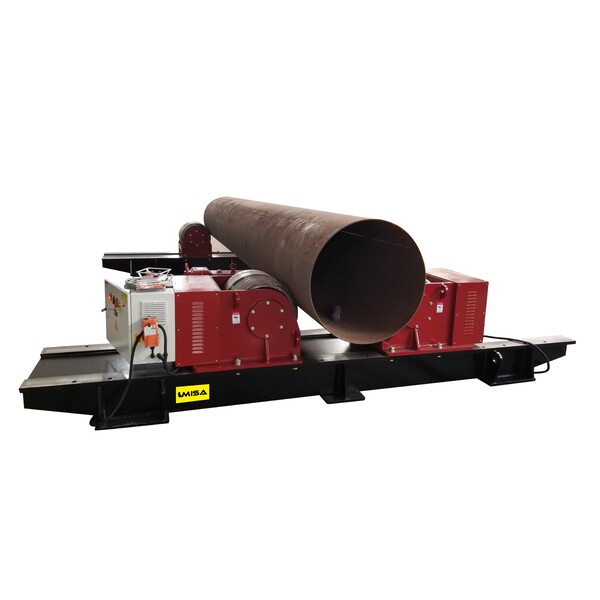
MISA MCR-60 Conventional Welding Rotator feature all-fabricated-steel base construction with wheel brackets that can be manually positioned to accommodate vessels of varying diameters around a constant center-line. Vessel rotation is via a two-motor, two-wheel-drive system which eliminates the need for torque tubes. Drive motors are inverter-controlled variable-frequency AC-type, protected by a cover shell and are fully enclosed for trouble-free operation.
60 Ton Drive/Idler Rotator Set S.W.L Capacity
600mm to 4500mm Vessel Diameter Range
Polyurethane Wheels
Bolt or Screw Adjust Roller Spacing
Wired Remote and Wireless Remote Optional
Lifting Rings and Forklift Slots
CE/ UKCA/ CSA/ SGS



Specification
| Model | MCR-60 Conventional Welding Rotator (Drive & Idler) |
| Load Carrying Capacity, Drive | 30 ton maximum |
| Load Carrying Capacity, Idler | 30 ton maximum |
| Load Carrying Capacity, Set | 60 ton maximum (1 Drive & 1 Idler) |
| Rotation Capacity, Drive Roll | 60 ton maximum |
| Vessel Diameter Capacity | 23.6in to 177.1in (600 mm to 4500 mm) |
| Rotation Speed Range | 4.7 to 47.0 in/min (120 to 1200 mm/min) |
| Tire Type | Polyurethane, A95 durometer rating |
| Wheel Size | 17.7in diameter x 11.8in wide (Ø450x300mm) |
| Control Pendant | Wired 26 ft (8m) cable + Optional Wireless (FWD/Stop/REV/Speed control/ Emergency stop) |
| Rotation Drive Motors | 2 x 2.2 kW |
| Primary Input Power | 220-480v,50/60hz.,3ph |
| Input Current at Rated Load | 10.0 A |
| Weight, Drive | 3417.1 lb (1650 kg) |
| Weight, Idler | 2314.8 lb (1150 kg) |
| Control Box Ingress Protection Rating | IP 54 |
A welding rotator is a device used to rotate cylindrical workpieces, such as pipes, tanks, and pressure vessels, to facilitate the welding process. By rotating the workpiece at a controlled speed, welding rotators ensure uniform welding seams, improve weld quality, and enhance productivity.
1. Conventional Welding Rotators:
2. Self-aligning Welding Rotators:
3. Fit-Up Welding Rotators:
MISA supply all kinds of welding rotators, including self-aligning type, conventional type and fit-up growing type. To learn more about fit-up turning rolls and anti drift turning rolls, please contact with our sales team.
Conventional Welding Rotators Self-aligning Welding Rotators Fit-up Growing Welding Rotator

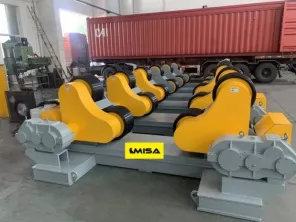
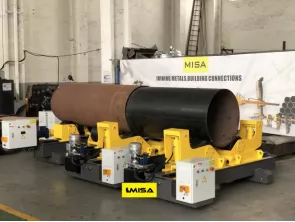
√ Standard match with CUL and CE
√ Professional design team
√ Motor power supply is equipped with safety protection
√ Perfect after-sales
√ 13 months warranty.
With the increasing frequency of use of welding rotators, more large-scale industrial manufacturing industries must use rotators to assist welding production.
Do you have a lot of questions about the welding rotators? We have compiled some common instructions on the use of the welding rotators for you.
Welding turning roll is just one of many devices that help you to carry out the welding production process more conveniently.

Example of what a welding turning roll looks like
Similar to the positioner, the welding rotator can help you do not need to manually move the workpiece during the welding process. What they do is basically to drive a cylindrical container or any other type of circular workpiece to rotate at a uniform speed, which can switch the direction of forward rotation and reverse rotation.
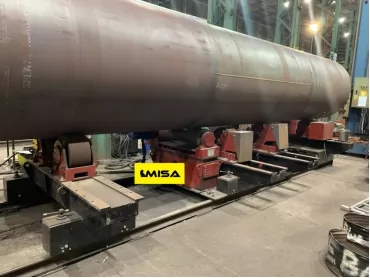
A homemade or a DIY welding turning roll without any additional parts.
However, many people are confused in distinguishing between welding turning rolls and positioners. Welding positioners are the machines you use where you clamp various workpieces, welding rotators rotate, twist, and turn workpieces automatically.
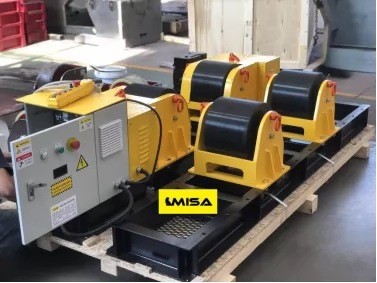
The picture clearly shows all the parts of the welding rotator
The regular welding rotator is comprised of two (2) parts: One Idler, One Drive.
Idler bracket, also known as "base". It can carry wheels, and the workpiece can rotate on it.
The components supported by the idler include:
Similar to the structure of the idler support unit, the motorized drive unit is also composed of different parts and components.
The motorized drive device is a part of the welding rotator, which emits power and energy to make the welding rotator work.
Among them, the controller and the motor are the two most important parts of the motorized drive device.
These are the components of the welding rotators. Some welded rotor manufacturers and suppliers may add some other parts to enrich this product. These are the common parts that are necessary for welding rotators.
Almost everyone is confused about this: What is the difference between a welding positioner and a welding turning roll? Is the function the same?
This is a good question.
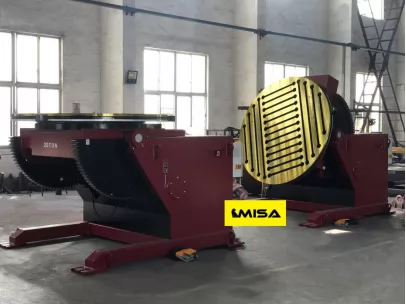
Sample image of the appearance of the welding positioner
The welding positioner is a device used to drag the workpiece to be welded to move the welding seam to the ideal position for welding operation.
The welding positioner worktable has a degree of freedom of overall turning. The workpiece can be turned over to the ideal welding position for welding. In addition, the worktable has a degree of freedom of rotation.
This product is mainly composed of rotating machine head, displacement mechanism and controller. The speed of the rotating machine head is adjustable, with an independent speed regulation circuit, and the DIP switch directly presets the length of the weld. The inclination angle of the table can be adjusted as required.
The welding rotator drives the workpiece, parts and components to rotate; the welding positioner is repositioning, can rotate and flip, and fix the workpiece in an ideal position so that the welder can reduce the workload.
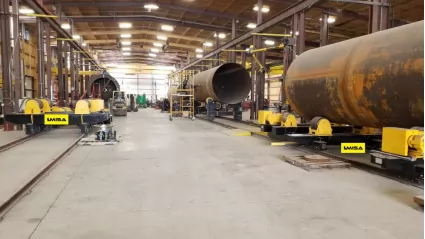
The welding rotator can be used in the production process of submerged arc welding or SAW, and the welding work goes on smoothly.
The welding rotator can be used to supplement and assist a large number of welding processes, including but not limited to:
If you choose to use a welding rotator to complete any of these processes, you can expect faster, more accurate, more precise and higher quality products.
The following are some commonly used welding systems:
1. Welding Equipment Brands
Lincoln Electric: One of the largest and most respected welding companies in the world, offering a wide range of welding machines, consumables, and automation solutions.
Miller Electric: Known for its high-quality welding equipment, including MIG, TIG, and stick welders, as well as plasma cutters.
ESAB: A global leader in welding and cutting solutions, offering advanced equipment for various industries.
Fronius: Renowned for its innovative welding technologies, particularly in TIG, MIG, and arc welding.
Kemppi: A Finnish company known for its reliable and user-friendly welding machines and systems.
OTC Daihen: A Japanese brand specializing in welding robots and automation solutions.
Hypertherm: Famous for its plasma cutting systems, often used in conjunction with welding equipment.
2. Automation and Robotic Welding Brands
Fanuc: A global leader in industrial robotics, including robotic welding systems.
ABB: Offers a wide range of robotic welding solutions and automation technologies.
KUKA: Known for its advanced robotic welding systems and automation solutions.
Panasonic: Provides robotic welding systems and welding equipment for various industries.
3. Niche and Regional Brands
EWM: A German brand known for its high-performance welding machines and innovative technologies.
Lorch: Specializes in high-quality TIG and MIG welding machines.
Cigweld: An Australian brand off
The rotor without a controller or power box is a manually adjusted welding rotator.
Therefore, the manual adjustment welding rotator is a rotator without computer numerical control or CNC functions.
This basically means that workers must manually adjust the speed, frequency and height of the spinner by inputting it to the control system.
This is the true definition of the manual adjustment of the welding rotator.
You can buy a manually adjustable welding rotator and try it out. But in fact, because it requires less control when you use it, experts will even recommend them even more.
The welding rotator can be widely used in many welding jobs and business fields.
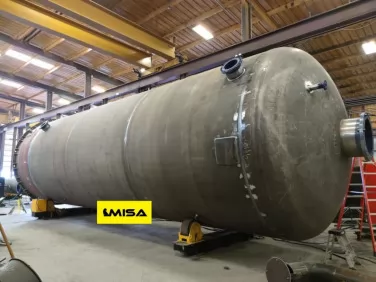
It is most commonly used in the production of storage vessels and pressure vessels, with the help of the function of welding rotators.
In addition, the most common application of welding rotator also includes welding other equipment:
Contrary to the perception of many people, the welding rotators are not limited to a single model of machine.
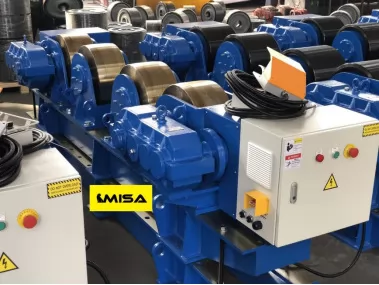
Fit Up Growing Line - one of the most commonly used welding turning rolls
In fact, there are many other types of welding rotators on the market today. Some of the most common types include:
These are welding rotators whose steering rollers can be easily adjusted in width and distance to suit the size of the workpiece, or the circumference and width of the material you will be welding.
Similar to the adjustable welding rotators, the rotator can adjust the wheel spacing to suit the size of the workpiece. The accuracy and precision of the weld can be guaranteed.
The pipe pinching rotators, judging from its terminology, is a welding turning roll that is clamped on pipes or any type of cylindrical objects to help them perform automatic welding.
These machines are the best and the most ideal for solving the problems of tilting or rotating pipes and other materials of the similar state, size, and dimensions.
The self-aligning welding rotator can automatically adjust the roller to accept any diameter cylinder within the specified diameter range. This type of machine is usually used to deal with changes in the diameter of the cylinder, from job to job. The roller shell of this type of turning roll is hinged on the based and opens automatically when a larger diameter workpiece is introduced. In this type of turning roll, each roller bracket assembly has two independent roller assemblies, so it can support a wider range of work. The two sets of rollers of the drive unit provide final drive to provide better traction for work
Why does the workpiece move on the welding rotator?
When using a welding rotator, both the rotor and the weldment are circular, the distance between the rotor and the cylinder is the same as the length of the cylinder, and the axis is parallel, which will not cause shaking.
If one of the rollers of the welding rotator is damaged, the workpiece on the turning roll may cause shaking.
Of course, if the shape or size of the workpiece is irregular, it will also cause shaking. This is because the axis of the rotor is not parallel to the axis of the workpiece.
What are the effects of using the welding rotator on the processing quality?
During the welding process, the welding rotator will be used to complete related operations. The professional design of the welding rotator and advanced production technology, and an automatic tracking system to achieve the application purpose, make the positioning more accurate. When the welding rotator is processed and produced, the process design can be carried out according to customer requirements, so that the welding rotator can better meet the needs of use.
Any problems encountered during processing and production can be analyzed, controlled and adjusted through appropriate methods. In addition, the welding rotator will be tested on the process parameters to make the parameter setting more reasonable, make the processing operation consistent with the equipment setting, and achieve better operation control effects.
1. What are the materials of the wheels?
Rubber, polyurethane or steel wheels.
2. What is the difference between conventional and self-aligning?
The conventional welding turning roll requires the customer to manually adjust the distance of the rollers within the effective range of the equipment. It's a bit convenient, flexible, and low price.
The self-aligning welding turning roll only needs to place the cylinder on the equipment, and there is no need for manual adjustment within the effective range of the equipment, but the price is higher than conventional.
3. What is included in one set of Welding Turning Roll ?
One set Welding Turning Roll include 1 drive roller & 1 idler roller, and 1 electrical cabinet with hand remote.
4. How to adjust the base of the conventional Welding Turning Roll ?
We have bolt adjustment and screw adjustment to choose from. If there is no special requirement, it will default to bolt adjustment.
5. Do you provide warranty?
We provide a 13-month warranty and can provide customers with technical guidance for life.
6. Replacement parts can provide it?
We provide it for free during the warranty period, and charge for it after the warranty period.
Welding manipulator is a kind of equipment used for automatic or semi-automatic welding, which is widely used in many industries. It is mainly used in the following fields:
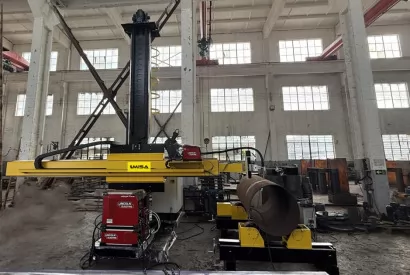
Welding manipulators can realize automatic welding through programming and reduce manual intervention. Accurately control the position and angle of the welding gun to adapt to complex welds. Usually have multi-axis motion function to adapt to different welding needs. And can adjust parameters such as current, voltage, speed, etc. to optimize welding quality.
Automated welding using welding manipulators significantly improves production efficiency, and accurately controls welding parameters to ensure uniform and firm welds. It can be applied to a variety of welding processes and materials.
Common types of welding manipulators:
Welding manipulators have the production advantages of intelligence, integration, and high precision. By introducing artificial intelligence and machine learning, the welding process is made intelligent. Integrate with other automation equipment, such as welding rotators and welding positioners, to form an automated production line. Automated production improves welding accuracy and adapts to high-precision manufacturing needs.
Welding manipulators play an important role in multiple industries, and their application range will be further expanded with technological advances.
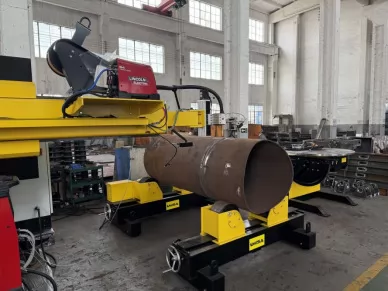
Welding rotators and welding manipulators are commonly used equipment in welding processes. Their use can improve welding efficiency and quality.
Application scenarios: Suitable for circumferential welding of cylindrical workpieces, such as pipes, storage tanks, etc.
- Operation process:
Advantages of integrated use of welding rotators and manipulators:
Through reasonable matching, welding rotators and manipulators can significantly improve welding efficiency and quality.


